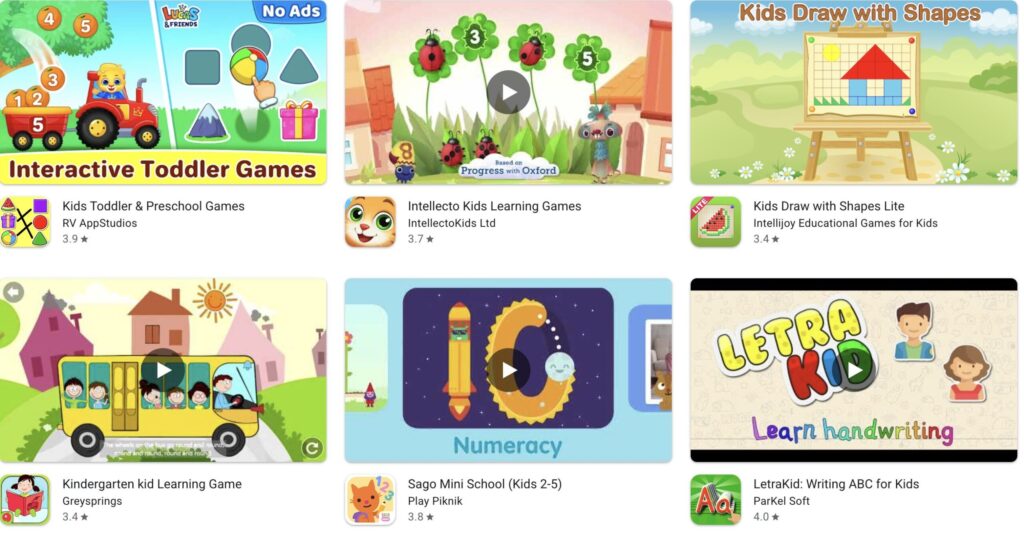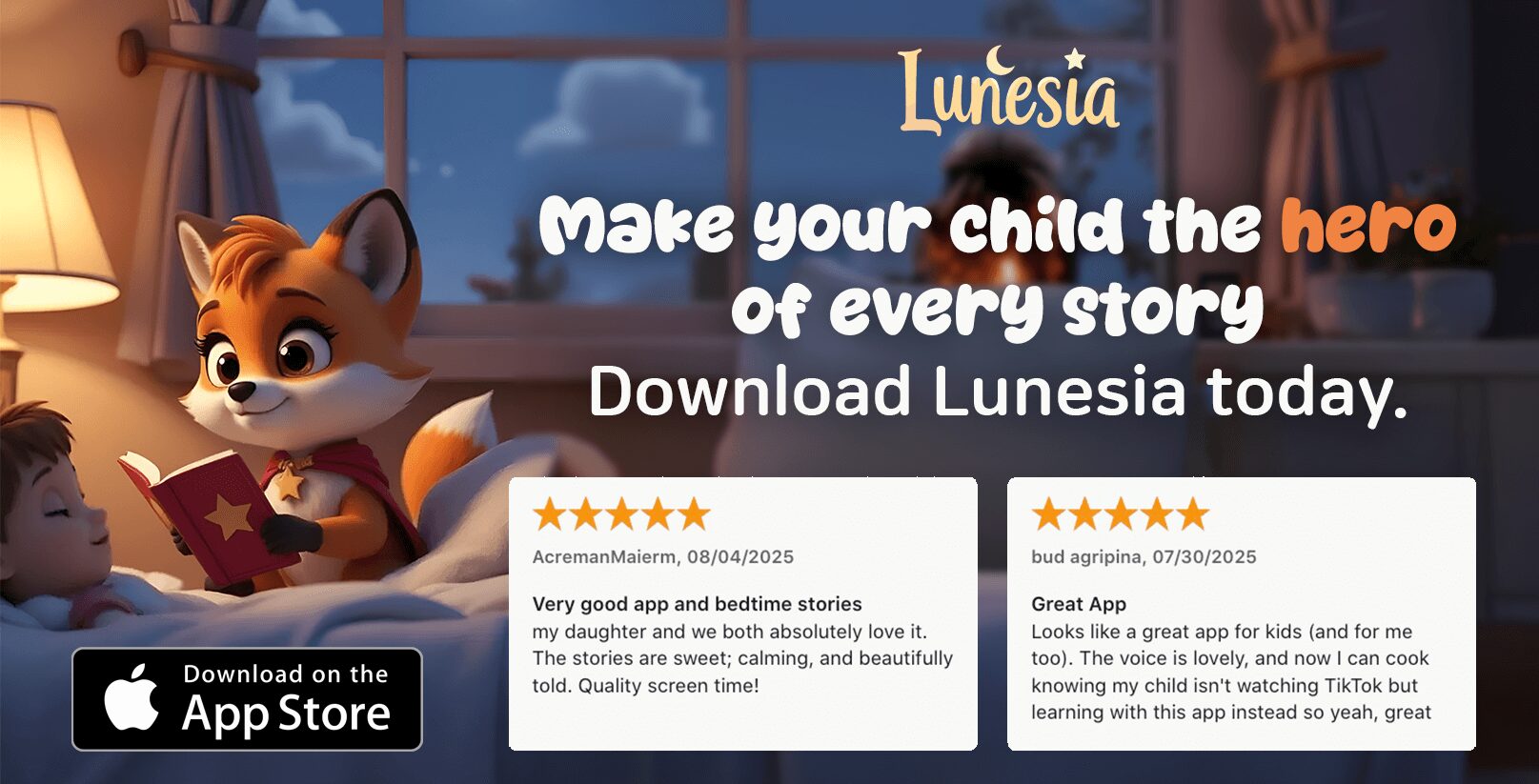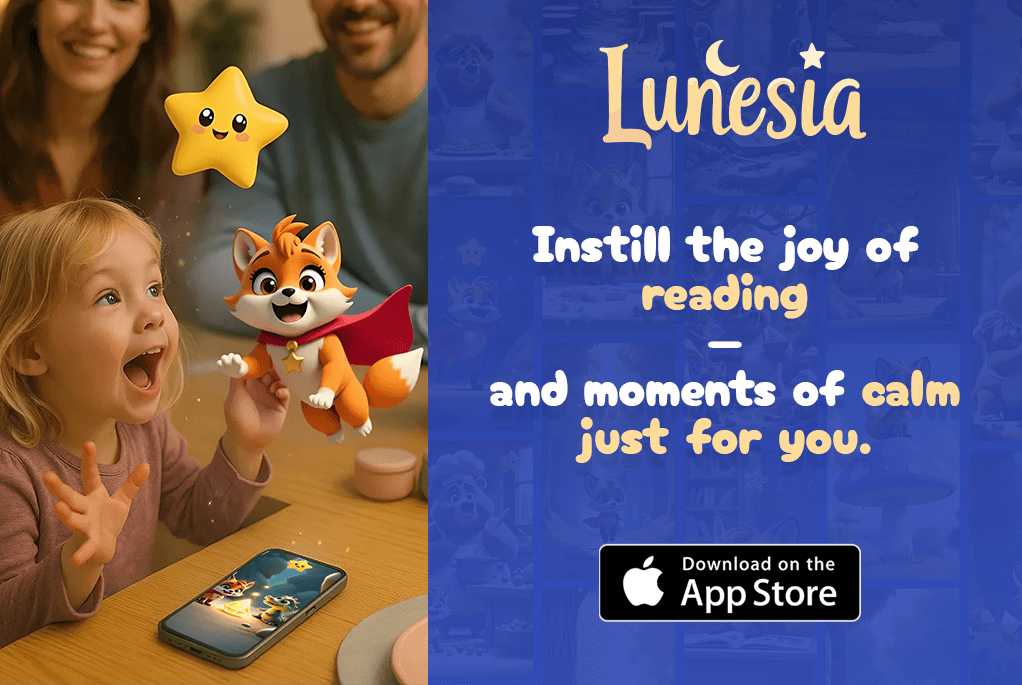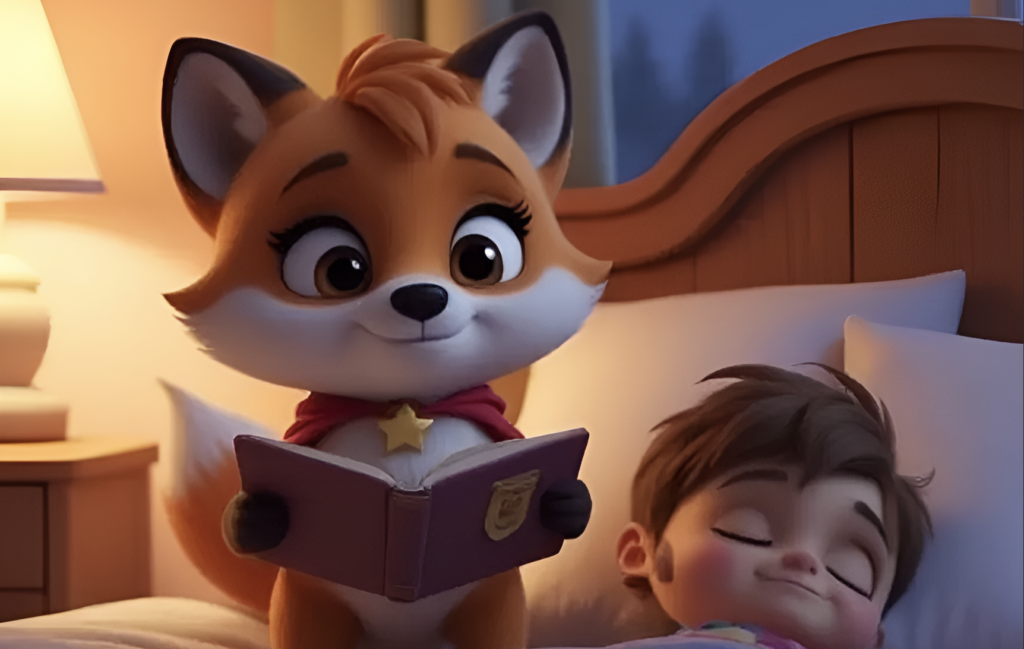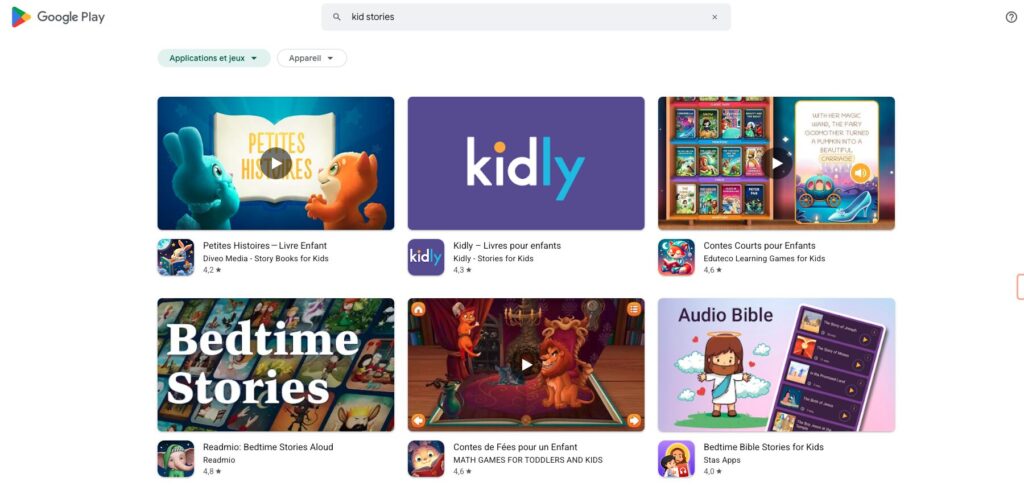Are you struggling to keep your kids creatively engaged without feeling guilty about screen time? You’re in the right place. Today’s digital landscape offers more than just passive content—there are apps designed to spark imagination, teach valuable lessons, and turn bedtime into a captivating adventure. In this article, I’ll share my personal journey of finding the best apps to develop creativity in kids, focusing on Lunesia, an enchanting interactive storytelling platform for ages 3–7 that helps children explore magical worlds and learn essential life values.
From conquering fears to fostering kindness, Lunesia and other creative apps can make screen time meaningful and educational. You’ll hear my own stories, stumbles, and successes, so you know exactly how to balance technology with real-world exploration. Ready to see how your child can grow braver and more imaginative—without sacrificing fun? Let’s dive into this ultimate guide to nurturing creativity, one story at a time!
When Screen Time Met Real Life: My Own Parenting Dilemma
I still remember the day I nearly caved under the pressure of balancing work calls, laundry piles, and a hyperactive toddler demanding attention. The ticking clock felt like a countdown to meltdown, and I thought, “Is this the day I just give my kid an old smartphone and hope for the best?” Seriously, I was this close to letting the screen babysit, which always felt like a last resort.
But then I realized something: technology doesn’t have to be mindless. If used thoughtfully, it can actually amplify a child’s creativity. Instead of a digital pacifier, I began to see screens as possible doorways to new adventures—if I carefully selected the right apps.
Now, I’m not saying that crayons, craft paper, and sunny backyard afternoons aren’t important—trust me, they are. My fridge is still plastered with painted handprints and lopsided stick-figure families. Yet, there was an undeniable magic that happened when I discovered the world of interactive storytelling apps. Suddenly, my daughter wasn’t just watching a cartoon; she was shaping the story herself, making decisions that impacted the plot, and learning about kindness, bravery, and empathy along the way.
That’s when I knew: the real secret is not about “screens = bad” or “screens = good,” but about how you use them. With a tool like Lunesia—an interactive story app specifically designed for young minds—you can let your kids shape their adventures, build valuable life skills, and still find time to get your own work done. Plus, bedtime routines become so much smoother when the story on the screen encourages them to drift off with a sense of wonder.
Why Creativity Matters More Than Ever
Today’s kids live in a world filled with constant notifications, viral videos, and flashy games. It’s easy for them to become passive consumers of entertainment. As a parent, I’ve had that creeping worry: “Is my child’s imagination getting buried under all these digital distractions?”
But here’s the thing: creativity isn’t just about painting pretty pictures or writing stories. It’s an essential life skill. It teaches kids to think outside the box, solve problems, adapt to new situations, and communicate their feelings. Whether they grow up to be engineers, doctors, artists, or entrepreneurs, creativity will be the X-factor that sets them apart.
And guess what? Apps like Lunesia don’t just entertain—they actively encourage your child to participate in the storytelling, make choices, and imagine different outcomes. They’re learning to see multiple perspectives, build resilience (when their chosen path leads to a plot twist), and empathize with characters. That’s real creative growth right there.
Of course, the device itself doesn’t guarantee creativity. If your child is zoning out to the same repetitive game 24/7, that’s a problem. But if you introduce them to the best apps to develop creativity in kids, you can transform screen time into a nourishing, mind-expanding opportunity.
Trust me, as a mom who used to dread that “zombie stare” kids get when they’re glued to the screen, it’s a huge relief to see them bouncing with excitement—ready to shape a new story, solve a puzzle, or discover a new way to face their fears in a magical forest.
The Game-Changer: Lunesia’s Interactive Storytelling
I’d already been burned by a few so-called “educational” apps that were 90% ads and 10% actual content. But the moment I downloaded Lunesia, something stood out—it was purely focused on the story experience and the emotional growth of the child.
Here’s why Lunesia completely stole my heart:
- Interactive Adventures: My child becomes the main character in each story, making choices that influence the plot’s direction. This fosters creativity, decision-making, and a sense of control—perfect for an age group (3–7) that craves both guidance and independence.
- Meaningful Lessons: Each adventure subtly weaves in moral themes like love, kindness, sharing, and respect. My daughter once exclaimed, “I want to help the lost bear find her family!” That moment melted my heart and showed me she was absorbing important values while playing.
- Child-Centric UX: The app’s interface is so intuitive that my kid navigated it with zero frustration. She tapped on items, listened to story prompts, and happily made her choices without needing me to decode complicated menus.
- Focus on Emotional Growth: Some stories tackle fears or worries—like monsters under the bed or feeling lonely at school. But they do it gently, helping children learn bravery in a supportive environment.
- Perfect for Bedtime: If you’ve ever had bedtime battles, you’ll appreciate how Lunesia can transform chaos into calm. The soothing voices, enchanting illustrations, and bedtime-friendly adventures help kids wind down in a way that’s both fun and reassuring.
The best part? No hidden in-app purchases and no ad spam. You can just let your child immerse themselves in these magical tales while you savor a well-deserved break (or fold that mountain of laundry… but I’d suggest grabbing a quick moment of relaxation instead).
The Boredom is Good Myth—And Why We Need Balanced Screen Time
You might have heard that letting kids be bored fuels their creativity. And, honestly, I’ve read the same articles and tried it in practice. There’s some truth there: unstructured play can spark inventive ideas. I’ve seen my kids turn cardboard boxes into spaceships and pillows into mountain ranges.
But let’s get real. Sometimes, parents just need a reliable tool to occupy their children in a constructive way. Whether it’s because you need to focus on a work deadline or you simply want a stress-free bedtime routine, apps like Lunesia can be that tool—without the guilt of mindless screen time.
It’s all about balance. I still encourage my kids to play with blocks, paint with actual brushes, and run around outside. But when I do allow screen time, I make sure it’s something that sparks their creative juices rather than draining them.
My First Steps Into Interactive Stories (A Personal Anecdote)
Let me share a little story (pun intended). One rainy afternoon, my five-year-old son was sulking around the house. We’d already baked cookies, played with LEGOs, and read half of his favorite dinosaur book. He was restless, and I needed to jump on a video conference in 15 minutes.
Instead of handing him the TV remote, I launched Lunesia on our tablet and said, “Hey, want to help the Knight of Kindness find his missing shield?” His eyes lit up like Christmas lights. By the time my meeting ended, he had solved mini-puzzles, helped the knight make decisions to show kindness to grumpy villagers, and learned a lesson about sharing his cookies with a talking squirrel.
When I came back, he excitedly recounted each step of the story. He even asked if we could bake more cookies “for the squirrel,” which in real life meant, “Mom, can we do something nice together?” That was a magical parenting win—a digital experience that enriched our offline connection.
Harnessing the Power of Interactive Story Apps for Emotional Growth
Why do I keep harping on emotional growth? Because creativity and emotional intelligence go hand in hand. Think about the most creative people you know—they’re often also very empathetic and emotionally attuned. They see possibilities where others see walls, and they connect deeply with their audience or colleagues.
Lunesia’s stories are designed to reflect real-life feelings that children experience: fear of the unknown, shyness around new friends, the desire to feel brave, or the joy of sharing. By letting them practice these emotions in a safe digital space, they grow more confident in real life.
Of course, Lunesia isn’t the only app that fosters creativity. But it’s a standout for ages 3–7 because it hits that sweet spot between story-based learning, moral lessons, and a user-friendly interface. I’ll highlight a few more apps for older kids in a moment, but if you’re the parent of a preschooler or a kindergartener, keep Lunesia at the top of your list.
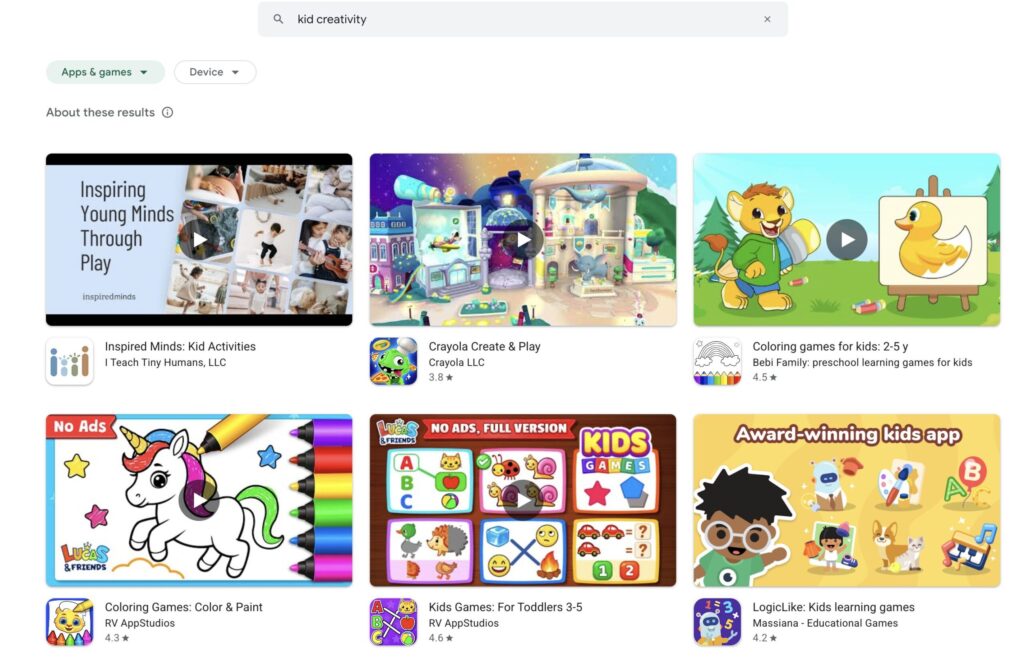
Other Must-Try Apps to Develop Creativity in Kids
While Lunesia is my go-to recommendation for interactive stories and building moral foundations, there are a few other gems I’ve discovered that complement the experience for slightly older kids or those with different interests. Let’s explore:
Chess for Kids — Play & Learn
- Ages: 4+ (with adult guidance)
- Highlights: Ad-free environment, interactive tutorials, and an online community for kid-friendly matches.
- Why It’s Cool: Chess is a classic game of strategy that boosts critical thinking. My daughter used to say, “Mom, the queen is the strongest piece, so I have to protect her.” That kind of strategic planning can be a gateway to broader problem-solving skills.
- Parent Tip: If your child is frustrated by losing games, switch to the app’s “play with bots” mode or set matches where they start with an extra piece—this can help them ease into the game.
Kahoot! Algebra by DragonBox
- Ages: 5–8, depending on their math readiness
- Highlights: Turns algebraic concepts into fun puzzles, multiple award winner.
- Why It’s Cool: It sneaks in math learning without feeling like a drill. My kids squeal with excitement when they “find X,” and I can’t deny how satisfying it is to see them enjoy algebra.
- Parent Tip: Don’t rush them through levels. Let them replay earlier puzzles if they want—it reinforces their understanding.
Simple Physics
- Ages: 7+
- Highlights: Design virtual structures like treehouses, then test them for durability.
- Why It’s Cool: Encourages kids to fail forward. When their Ferris wheel collapses, they must figure out why. It promotes resilience and engineering thinking.
- Parent Tip: Talk through designs with your child. Ask, “Why do you think this beam is breaking?” or “Should we add more support here?” to build problem-solving dialogue.
SkyView Lite
- Ages: 5+
- Highlights: Offline stargazing, identify constellations by pointing your device at the sky.
- Why It’s Cool: It transforms a simple evening walk into an astronomy adventure. My kids love spotting planets or shooting stars and then researching them the next day.
- Parent Tip: Pair it with a real telescope if you have one. If not, a simple pair of binoculars can still enhance the experience.
Thinkrolls Space
- Ages: 4–9
- Highlights: Puzzle-solving in whimsical outer-space worlds filled with quirky characters.
- Why It’s Cool: Kids learn cause-and-effect relationships while navigating obstacles. The cartoonish aliens and robots keep them giggling.
- Parent Tip: Encourage them to switch levels or replay older ones if they get stuck. Overcoming challenges in a puzzle context builds perseverance.
WWF Together
- Ages: 6+
- Highlights: Learn about endangered species, fold origami animals, and engage with interactive facts.
- Why It’s Cool: Instills empathy for wildlife and the environment. My son once spent a whole afternoon trying to perfect a paper elephant, inspired by WWF’s instructions.
- Parent Tip: Use it as a jumping-off point for real-life discussions about conservation. “How can we help protect elephants?” might spark a family project or donation drive.
All these apps have something in common: they’re not just about passively tapping away; they offer meaningful experiences that challenge kids to create, think, and learn.
Table: Quick Comparison of Creative and Educational Apps
| App | Age Range | Key Skills Developed | Unique Selling Point |
|---|---|---|---|
| Lunesia | 3–7 | Emotional intelligence, empathy | Interactive storytelling for moral lessons |
| Chess for Kids | 4+ | Strategy, logical thinking | Ad-free, child-friendly chess tutorials |
| Kahoot! Algebra | 5–8 | Math concepts, problem-solving | Gamified algebra, multiple awards |
| Simple Physics | 7+ | Engineering, resilience | Hands-on virtual building and stress tests |
| SkyView Lite | 5+ | Astronomy, curiosity | Offline star-gazing with interactive sky map |
| Thinkrolls Space | 4–9 | Logic, puzzle-solving | Funny alien characters, progressive levels |
| WWF Together | 6+ | Environmental awareness | Interactive animal facts & origami |
Consider your child’s interests. Do they love animals? WWF Together might be perfect. Obsessed with building stuff? Simple Physics is a win. Want to encourage emotional growth and kindness? Lunesia should be your go-to.
Making the Most of Lunesia: A Step-by-Step Tutorial
Since Lunesia is all about interactive storytelling designed for young children, I want to share exactly how I use it in my own home. Ready? Let’s go:
- Download and Install
- Head to the Google Play Store or the Apple Store, search for Lunesia, and install the app.
- Make sure you have enough storage space on your device. The stories come with engaging audio and illustrations, so a bit of memory is good to have.
- Set Up Your Account
- Once installed, you’ll be prompted to create a child-friendly profile. Enter your child’s name or a fun nickname.
- No complicated passwords or hoops to jump through—it’s all straightforward, which I appreciate for a kids’ app.
- Choose Your First Adventure
- Lunesia provides a curated library of magical stories. Let your child pick one that intrigues them (like “The Brave Little Explorer” or “Kindness in the Enchanted Forest”).
- Encourage them to read—or listen to—the quick story synopsis. This builds excitement before diving in.
- Listen and Engage
- The app narrates the story with delightful voices and sound effects. Have your child wear headphones if you’re in a busy environment, or listen together for a cozy bonding experience.
- My personal tip: sit next to them for the first story. Ask guiding questions like, “How does that character feel?” or “What do you think will happen next?”
- Make Choices, Shape the Adventure
- At certain points in the story, your child will need to make decisions—“Should we follow the mysterious glow or stay on the main path?”
- This is the heart of interactive storytelling. Reinforce that no choice is ‘wrong’—they just lead to different outcomes. It’s like real life, where every decision has a consequence.
- Pause, Reflect, and Discuss
- After finishing a story or reaching a plot twist, take a quick break. Chat about what happened. “Did the character make a good choice? How do you think they felt?”
- These mini-conversations help your child develop emotional awareness and empathy.
- Rinse and Repeat
- Lunesia’s library offers countless adventures. Next time, let them pick a different story or replay the same one with new choices.
- Each playthrough can unfold in surprising ways. It’s never the same experience twice, which keeps kids engaged and curious.
- Bedtime Magic
- If your child struggles with bedtime routines, use Lunesia as the final calming activity. A gentle story can guide them into dreamland without the usual bedtime battles.
- Pro tip: Lower the screen’s brightness and volume to create a peaceful atmosphere.
This step-by-step approach transforms a simple app into a collaborative storytelling journey. It’s not just your child tapping randomly; it’s you both exploring, learning, and bonding through creative narratives.
The Importance of Setting Limits
While I could rave about Lunesia all day, let’s keep it real: screen time limits are still crucial. Even the most educational app can’t replace outdoor play, physical movement, or hands-on art projects.
Here’s what I do in my own home:
- Create a Daily Routine: For example, 30 minutes of screen time after school and chores are done.
- Encourage Offline Extensions: If a Lunesia story talks about a magical tree, suggest drawing or painting that tree after.
- Parent as Guide: Occasionally monitor how your kid uses the app. If they’re skipping through dialogue and not engaging, maybe it’s time for a break or a different story.
- Look for Emotional Cues: If they seem frustrated or overstimulated, switch gears. Go outside for fresh air or read a paper book together.
Remember, the goal is meaningful screen time, not endless hours.
A Personal Reflection: The Day Lunesia Saved My Sanity
Let me share one more personal anecdote. I was having “one of those days”: deadlines looming at work, the washing machine decided to leak, and my youngest was in a cranky mood for reasons unknown. By 4 p.m., I was at my wit’s end.
I set my 4-year-old up with Lunesia, specifically the bedtime-themed story, even though it wasn’t bedtime yet. I said, “We might both need a little calm-down time, buddy.” He curled up on the couch, made story choices to help a small dragon overcome its fear of the dark, and eventually drifted off into a rare afternoon nap—listening to soothing narration.
That gave me just enough time to call the plumber and finish some urgent work tasks. When he woke up, he proudly told me how the dragon found a glowing flower to light its way. “Mom, I’m not scared of the dark anymore because the dragon was brave!” he declared. We turned a stressful day into a mini victory, all thanks to the gentle storytelling approach of Lunesia.
Making Bedtime Magical
If you’re like me, bedtime can feel like a daily marathon. You’re physically and mentally spent, yet your child somehow has the energy of a caffeinated squirrel. This is where interactive bedtime stories truly shine. Rather than a source of stimulation, they can be a guided wind-down ritual.
- Set the Scene: Dim the lights, lower the volume, and snuggle up together.
- Pick a Calm Story: Choose a Lunesia adventure specifically designed for bedtime—one that focuses on peaceful resolutions, gentle music, and comforting visuals.
- Encourage Reflection: After the story ends, ask, “What’s one thing you learned today?” or “How can you be brave like the dragon tomorrow at school?”
- Transition to Sleep: Turn off the screen and transition to lullabies or a soft nightlight. This teaches your child that the story is a stepping stone to real rest, not an invitation to stay awake.
This sequence transforms bedtime from a chore into a cherished family moment.
Sites and References for Further Exploration
Are you craving more resources to boost your child’s creativity and emotional intelligence? Here are my go-to recommendations:
- Common Sense Media: Offers reviews and age-appropriate ratings for kids’ apps, so you can check if an app truly aligns with your values.
- Children’s Technology Review: Delivers in-depth analyses of educational apps, bridging the gap between tech and pedagogy.
- Storyline Online: While it’s not interactive, it offers high-quality video story readings by celebrated actors. Great for quick literary enrichment.
- Psychology Today (Parenting Section): If you’re interested in the science behind emotional development, this site offers articles based on current research.
Why these matter? They help you stay informed, ensuring you’re investing your family’s time in resources that genuinely enrich your child’s learning journey.
Frequently Asked Questions
Is Lunesia free or paid?
Lunesia provides a free download with access to some stories. For full access to the entire story library and premium features, you can opt for a subscription. I like that they’re transparent about what you get for free vs. paid, so you won’t encounter unexpected fees or sneaky in-app purchases.
What age range is Lunesia best suited for?
Lunesia’s sweet spot is ages 3–7. The stories are carefully crafted with age-appropriate language, themes, and visuals. If your child is 8 or older, they might still enjoy it but could crave more advanced storylines or puzzles.
Can my child use it without supervision?
Yes, the interface is extremely kid-friendly. However, I recommend at least trying the first few stories together. It’s a lovely way to reinforce the emotional lessons and connect over the plot.
How do I handle screen-time limits with Lunesia?
Create a consistent schedule—like 20–30 minutes a day—and stick to it. You might allow a bit more time on weekends or special occasions, but the key is consistency. Pair digital stories with offline activities to keep a healthy balance.
Can Lunesia replace reading physical books?
No, it shouldn’t replace traditional reading. Think of it as a complementary tool. Both interactive digital stories and paper books have unique benefits. I still read physical picture books with my kids, but Lunesia offers an immersive, choose-your-own-adventure twist that print books can’t match.
Is Lunesia suitable for bedtime routines?
Absolutely! Lunesia even has bedtime-specific stories designed to relax and soothe kids. Keep the brightness low, set the volume softly, and opt for calmer narratives that help them wind down.
Does Lunesia require an internet connection?
You’ll need internet to download the stories initially. However, once they’re downloaded, you can often access them offline. That’s handy for travel or when Wi-Fi is spotty.
Are there any ads or third-party pop-ups?
No. One of the biggest perks of Lunesia is that it’s ad-free, making the experience safer and less distracting for children. You won’t have to worry about random pop-ups or hidden purchases.
How can I track my child’s progress?
Lunesia focuses more on the narrative journey than skill-based metrics. While there isn’t a formal “progress bar,” you’ll notice how your child grows in confidence and empathy by the way they interact with the stories and talk about them afterward.
Will the app be too scary for my child if it has stories about facing fears?
Lunesia approaches fears gently. Stories are designed to help children overcome common anxieties like the dark or meeting new friends. The visuals and themes remain child-friendly, making the experience empowering rather than frightening.
Wrapping It All Up (No “Conclusion” Mentioned in Title)
If there’s one thing I’ve learned, it’s that creativity thrives where guidance and freedom intersect. By choosing apps that emphasize open-ended play, emotional growth, and interactive storytelling—like Lunesia and the others mentioned—you’re giving your child more than just a digital distraction. You’re providing a window into new worlds, where they can safely explore, make choices, and learn from the outcomes.
In a world of endless digital noise, these curated apps become little islands of meaningful engagement. Yes, boredom still has its place in a child’s life—trust me, cardboard boxes will always have a special magic—but when you need a modern tool that fosters creativity and imagination, you can confidently tap “Install.”
As you wrap up your day, imagine the look of wonder on your child’s face when they help a friendly dragon conquer its fear of the dark or build a sturdy castle in a physics puzzle. That’s the power of well-chosen technology. It’s not about “screen time” versus “no screen time.” It’s about what they do with that screen—and how you support them on their quest.
So go ahead and explore these stories and apps. Challenge your little one to a chess match in Chess for Kids, or watch them beam with pride after completing a tricky puzzle in Thinkrolls Space. Then, at bedtime, settle down with Lunesia for a soothing adventure that teaches bravery and kindness.
Let’s make screen time a magical, growth-filled experience—one story, one puzzle, and one bedtime adventure at a time. Your kids—and your sanity—will thank you.
(Now, if you’ll excuse me, I have a small knight in shining armor to help as he searches for a missing shield in a brand-new Lunesia quest… Wish us luck!)
